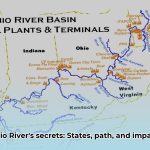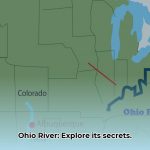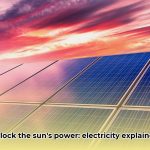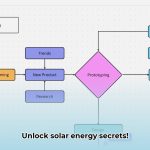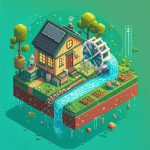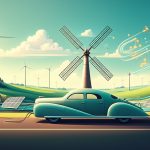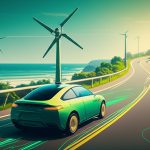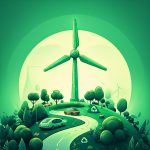How Does Hydropower Generate Clean Electricity?
From the rush of a mighty river to the gentle lapping of waves against the shore, water holds immense energy potential. This guide explores how we harness this power, focusing primarily on hydropower—the most established form of water energy conversion—and touching on exciting emerging technologies.
From Flow to Electricity: A Step-by-Step Guide
The process of converting water’s energy into electricity is surprisingly straightforward, yet remarkably powerful. It involves a series of energy transformations, starting with the potential energy of stored water and ending with the electrical energy that powers our homes.
-
Harnessing Potential Energy: Think of a reservoir behind a dam. The stored water, by virtue of its elevated position, holds potential energy. This is the energy of position, waiting to be unleashed.
-
Kinetic Energy Takes Over: When the dam’s gates are opened, the water rushes down a large pipe called a penstock. Gravity pulls the water downwards, converting potential energy into kinetic energy—the energy of motion.
-
Spinning Turbines: The fast-flowing water hits the blades of a turbine, causing it to spin rapidly. These turbines are similar to windmills, but instead of wind, it’s the force of moving water that drives the rotation. This spinning motion transforms the water’s kinetic energy into mechanical energy.
-
Generating the Spark: The spinning turbine is connected to a generator. Inside the generator, magnets and coils of wire interact to convert the turbine’s mechanical energy into electrical energy.
-
Power to the People: This newly generated electricity travels through power lines, delivering clean, renewable energy to homes, businesses, and communities.
Diverse Approaches: Different Types of Hydropower Plants
Hydropower isn’t a one-size-fits-all technology. Different types of hydropower plants exist, each suited to specific geographic locations and energy needs. This diversity allows us to harness water power in a variety of ways, maximizing efficiency and minimizing environmental impact.
| Type | Description | Advantages | Disadvantages |
|---|---|---|---|
| Conventional (Impoundment) | Involves building large dams to create reservoirs, storing vast amounts of water and releasing it to power turbines on demand. | Provides a reliable and consistent source of power; can also be used for flood control and water storage. | Can have significant environmental impacts, including altering river ecosystems and displacing communities. Requires substantial upfront investment. |
| Run-of-the-River | Utilizes the natural flow of a river without the need for large dams or reservoirs. Smaller structures divert a portion of the river’s flow to generate electricity. | Has a smaller environmental footprint compared to conventional hydropower; less disruptive to river ecosystems. | Power generation fluctuates with the river’s natural flow, making it potentially unreliable during dry periods. |
| Pumped Storage | Pumps water uphill to a higher reservoir during periods of low energy demand and releases it back down during peak demand to generate electricity. | Acts like a giant battery, storing energy for later use and helping stabilize the electricity grid. | Requires specific geographic locations with suitable elevation differences. The pumping process consumes energy, so overall efficiency is less than 100%. |
| Offshore | Harnesses the power of ocean currents, tides, and waves. Technologies include tidal barrages, tidal fences, tidal turbines. and wave energy converters. | Vast, untapped energy resource; potentially minimal environmental impact compared to traditional hydropower. | Technology still under development; high initial costs; long-term environmental effects uncertain; challenges in harsh ocean environments. |
Weighing the Scales: Benefits and Drawbacks of Hydropower
Hydropower offers compelling advantages as a renewable energy source, but it also comes with potential downsides that require careful consideration. A balanced perspective is essential for making informed decisions about its role in a sustainable energy future.
The Upsides: Why Hydropower Matters
-
Clean Energy Source: Hydropower generates electricity without burning fossil fuels, significantly reducing greenhouse gas emissions and air pollution.
-
Reliable and Consistent: Unlike solar and wind power, which are dependent on weather conditions, hydropower provides a relatively stable and predictable energy output. This reliability is crucial for maintaining a stable electricity grid.
-
Cost-Effective in the Long Run: Although hydropower plants require significant upfront investment, their operating costs are relatively low, leading to stable electricity prices for consumers.
-
Multi-Purpose Benefits: Reservoirs created by dams can serve multiple purposes, including flood control, water storage for irrigation, and recreational opportunities.
The Downsides: Addressing the Challenges
-
Environmental Impacts: Large dams can significantly alter river ecosystems, affecting fish migration, water quality, and natural habitats. Some studies suggest that careful planning and mitigation efforts can minimize these impacts, but they remain a significant concern.
-
Social Disruption: The construction of large dams can displace communities and disrupt traditional ways of life, raising social and ethical concerns. Ensuring equitable and ethical development is paramount.
-
Methane Emissions: The decomposition of organic matter in reservoirs can lead to the release of methane, a potent greenhouse gas. While research suggests that these emissions might be lower than originally thought, this is still an area of ongoing research.
-
Geographic Limitations: Hydropower projects are dependent on suitable geographic locations with access to flowing water and, in some cases, sufficient elevation differences. This limits their applicability in certain regions.
The Future of Water Energy: Innovation and Beyond
While hydropower remains the dominant form of water energy conversion, emerging technologies offer exciting possibilities for harnessing the power of water in new and innovative ways.
Riding the Waves: Wave and Tidal Energy
Wave energy converters capture the energy of ocean waves, while tidal energy harnesses the predictable rise and fall of tides. These technologies are still in their early stages of development, but they hold immense promise for tapping into the vast, untapped energy resource of the ocean.
Osmotic Power: Where Fresh and Saltwater Meet
Osmotic power explores the energy potential created when freshwater and saltwater meet. This difference in salinity generates pressure that can be harnessed to drive turbines and produce electricity. This emerging technology represents a fascinating area of research with the potential to revolutionize how we generate clean energy.
Conclusion: A Sustainable Flow of Energy
Water energy conversion, particularly hydropower, plays a crucial role in the global transition to renewable energy. While traditional hydropower offers proven benefits, it’s essential to acknowledge and address its potential environmental and social impacts. Ongoing research and innovation are key to minimizing these downsides and maximizing the benefits of this valuable resource. Furthermore, exploring and developing emerging technologies like wave, tidal, and osmotic power will be crucial for diversifying our renewable energy portfolio and securing a more sustainable energy future.
- How To Make Electricity At Home With Water Using DIY Micro-Hydro - December 7, 2025
- How to Generate Electricity from Water at Home for Off-Grid Power - December 6, 2025
- Small Scale Hydropower Brings Sustainable Energy to Rural Areas - December 5, 2025

